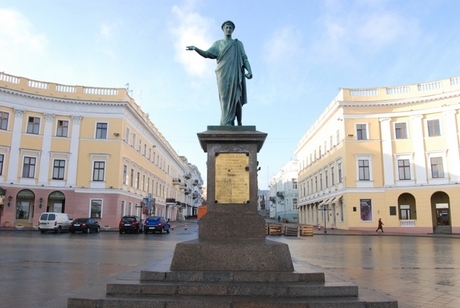Monument to Duke de Richelieu
Monument to Duke de Richelieu, located in Odessa on the Primorsky Boulevard, is a bronze statue of a full-length dedicated to Armand Emmanuel du Plessis, Duke de Richelieu, who made a solid contribution to the development of the city. The monument is directed to the sea, in front of it there are Potemkin Stairs, behind - the two buildings forming a square.
The monument to one of the founders of the city, Duke de Richelieu in Primorskiy Boulevard is one of the main places of interest of Odessa. Its pictures can be found on pamphlets, cards and even stamps. Duke de Richelieu (b. Sept. 25, 1766, Paris, Fr.--d. May 17, 1822, Paris), French nobleman, soldier, and statesman who, as premier of France (1815-18 and 1820-21), obtained the withdrawal of the Allied occupation army from France. Earlier, he had served Russia as governor of Odessa and was notable for his progressive administration there.
The son of Louis-Antoine-Armand du Plessis, duc de Fronsac, and grandson of Louis-François-Armand de Vignerot du Plessis, duc de Richelieu and marshal of France, Armand took over his grandfather's duties at court as first gentleman of the bedchamber (1785). On a visit to Germany and Austria in 1790 he joined the Russian army, fighting against the Turks at Izmail, and then visited Russia. Succeeding his father as duc de Richelieu (1791), he fought with the royalists under the Prince de Condé (1792) and with the Austrians (1793-94). Visiting Russia in 1795, Richelieu was appointed lieutenant colonel of the Cuirassiers of St. George, and later Tsar Alexander I appointed him governor of Odessa (1803) and governor general of New Russia, the area between the Dniester River and the Caucasus (1805). After cleaning up a corrupt administration, Richelieu transformed the Black Sea village of Odessa into a modern city. He constructed port facilities and encouraged agriculture and commerce.
Richelieu returned to France in 1814, but on Napoleon's return from Elba in 1815 he joined the Tsar's forces against Napoleon. He succeeded Talleyrand as prime minister with control of foreign affairs in September 1815. His friendship with the Tsar helped him to mitigate the demands of the Allies on France, and at the Congress of Aix-la-Chapelle (1818) he obtained the withdrawal of the Allied occupying army and the inclusion of France into the Quadruple Alliance. He resigned in 1818, became prime minister again in 1820, but was forced by political opponents to resign again in 1821.
Cardinal de Richelieu's descendant was obliged to immigrate to Russia due to the Great French Revolution where he distinguished himself in the seizure of Ismail. In some time he obtained the position of governor-general of Odessa. In spite of that he became a governor of Odessa only in 1803 (since 9 years after its foundation), its contemporaries honoured him as one of the founders of the city. After 11 years of governing of the city he was promoted replacing Talleyrand on the position of prime-minister of France. After 6 years he resigned and was going to return to Odessa to live the last years of his life in "his new homeland". But the fate decreed otherwise: in a few months after the resignation Arman Emmanuele de Rishelieu died of the stroke at the age of 56 years old.
The monument's basement has three bas-reliefs symbolizing agriculture, justice system and trade. The last of them, the pouch, is very popular among tourists. According to the inadequate information, a person who will touch it can expect improvement his business-skills, success and richness. During the Crimean War the English-French squadron attacked Odessa. So this war action has its reflection in the monument Duke. One of the cannonballs damaged the base of the monument. On its place a cast-iron patch with a stylized cannonball was installed. According to one of the versions the reason of its instalment - is a certain curiosity of the situation: "the French fired at the monument to its ex prime-minister" and the special Odessa humour.
Richelieu became governor of Odessa in 1803, and residents of the city called him “our Duke”, considering him the founder of the city that really was far from the truth, because at that time Odessa was 8 years old. Thank to this governor the city had become a major trading port. With the return of the Bourbons on the throne, Richelieu returned to France, where he died in 1822. Having received this news from Paris, Count Langeron began raising money from people for the construction of the monument, and Novorossiysk Governor-General, who took the post in May 1823, ordered it to his sculptor I.P. Martos. The grand opening of the monument took place on April 22, 1828.
Statue of Richelieu figure is presented in full growth, the mayor wearing a toga and holding a scroll. Monument is casted in bronze, and bears the imprint of the classicism. The square pedestal was donated by the landowner Skaroninsky, the base of the pedestal is shaped like a truncated pyramid, and was made from local limestone.
Monument to Duke de Richelieu is known for a very fun fact: if you look at the monument with the left water hatch, the scroll in the hand of the mayor and the folds of his clothes look like male genitalia.




